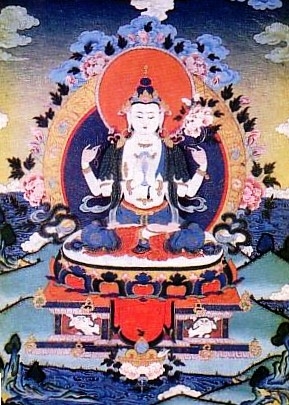Mani Kabum: Difference between revisions
Jump to navigation
Jump to search
| Line 5: | Line 5: | ||
*[[Matthew Kapstein]], 'Remarks on the Maṇi bKa'-'bum and the Cult of Āvalokiteśvara in Tibet', in ''Tibetan Buddhism: Reason and Revelation'' edited by Steven D Goodman and Ronald M. Davidson, SUNY, 1992 | *[[Matthew Kapstein]], 'Remarks on the Maṇi bKa'-'bum and the Cult of Āvalokiteśvara in Tibet', in ''Tibetan Buddhism: Reason and Revelation'' edited by Steven D Goodman and Ronald M. Davidson, SUNY, 1992 | ||
*Matthew Kapstein, 'The Royal Way of Supreme Compassion', in ''Religions of Tibet in Practice'', edited by Donald S. Lopez Jr., Princeton University Press, 1997 | *Matthew Kapstein, 'The Royal Way of Supreme Compassion', in ''Religions of Tibet in Practice'', edited by Donald S. Lopez Jr., Princeton University Press, 1997 | ||
[[Category:Texts]] | [[Category:Texts]] | ||
[[Category:Nyingma]] | [[Category:Nyingma]] | ||
Revision as of 13:28, 8 February 2016

Mani Kabum (Wyl. ma Ni bka' 'bum) - a collection of teachings and practices focused on Avalokiteshvara, attributed to King Songtsen Gampo and revealed as a terma by three different masters: the siddha Ngödrup, Nyangrel Nyima Özer, and Shakya Ö.
Further Reading
- Bryan Phillips, “Consummation and Compassion in Medieval Tibet: The Mani bka’-‘bum chen-mo of Guru Chos-kyi dbang-phyug” (unpublished PhD thesis)
- Matthew Kapstein, 'Remarks on the Maṇi bKa'-'bum and the Cult of Āvalokiteśvara in Tibet', in Tibetan Buddhism: Reason and Revelation edited by Steven D Goodman and Ronald M. Davidson, SUNY, 1992
- Matthew Kapstein, 'The Royal Way of Supreme Compassion', in Religions of Tibet in Practice, edited by Donald S. Lopez Jr., Princeton University Press, 1997